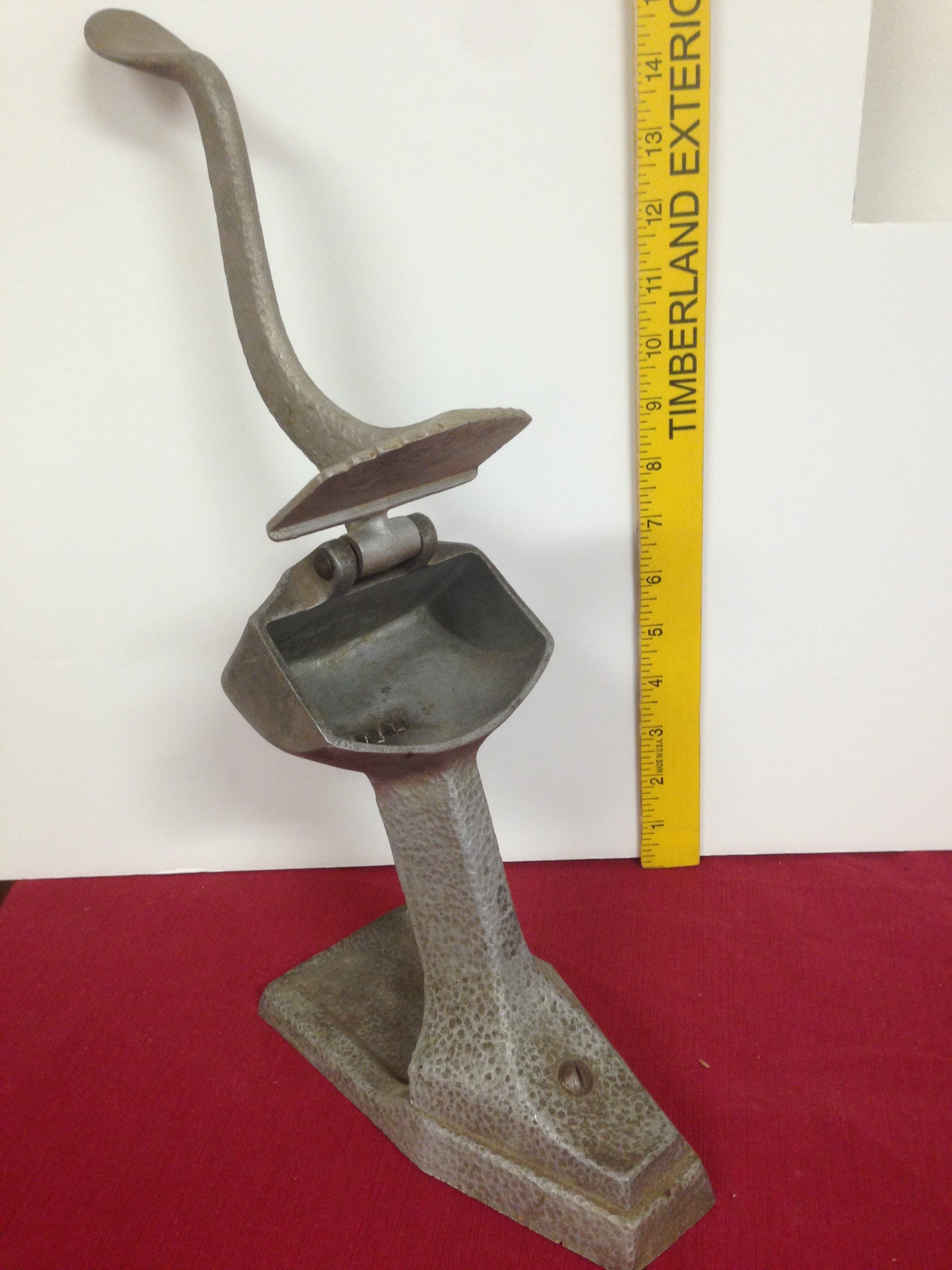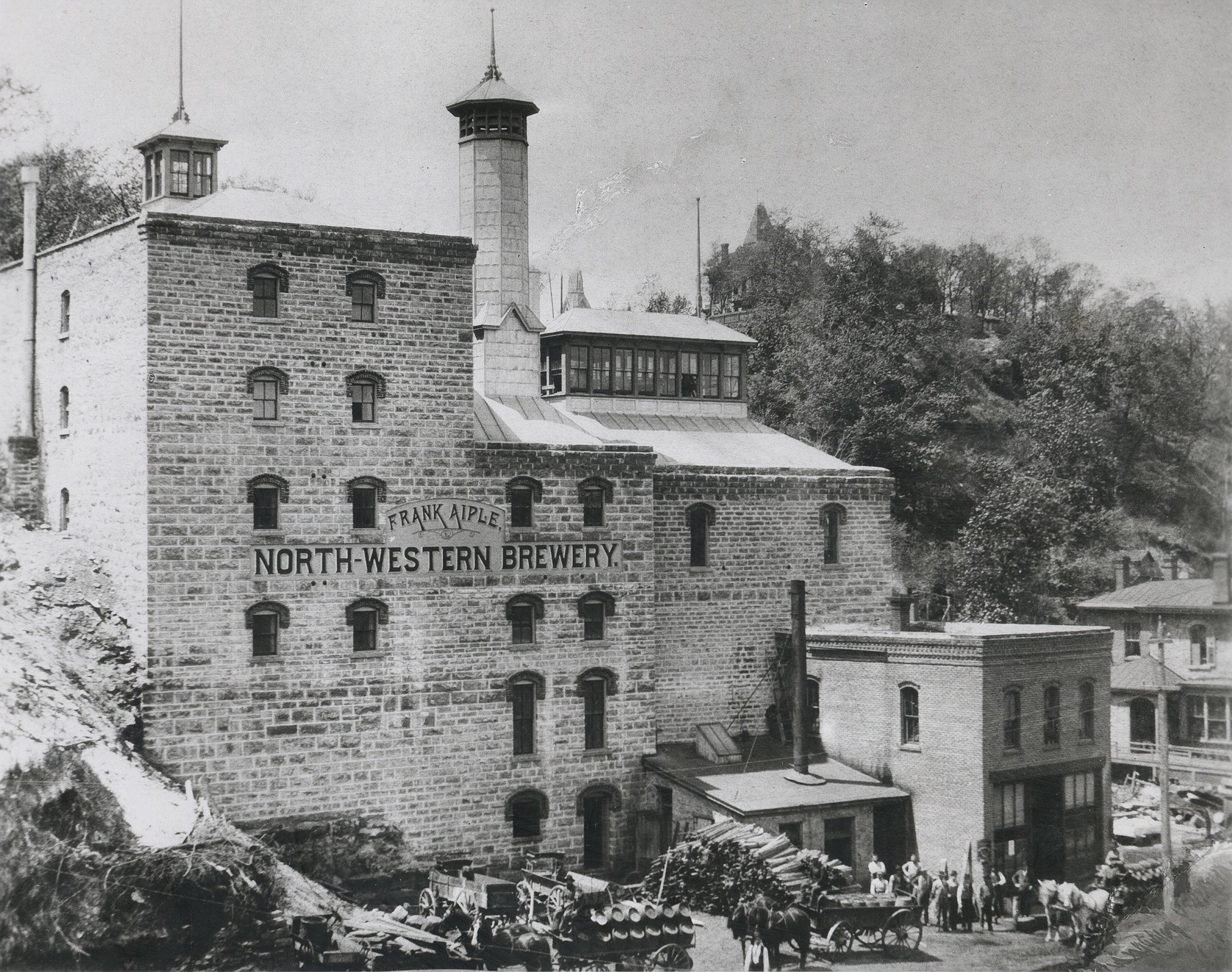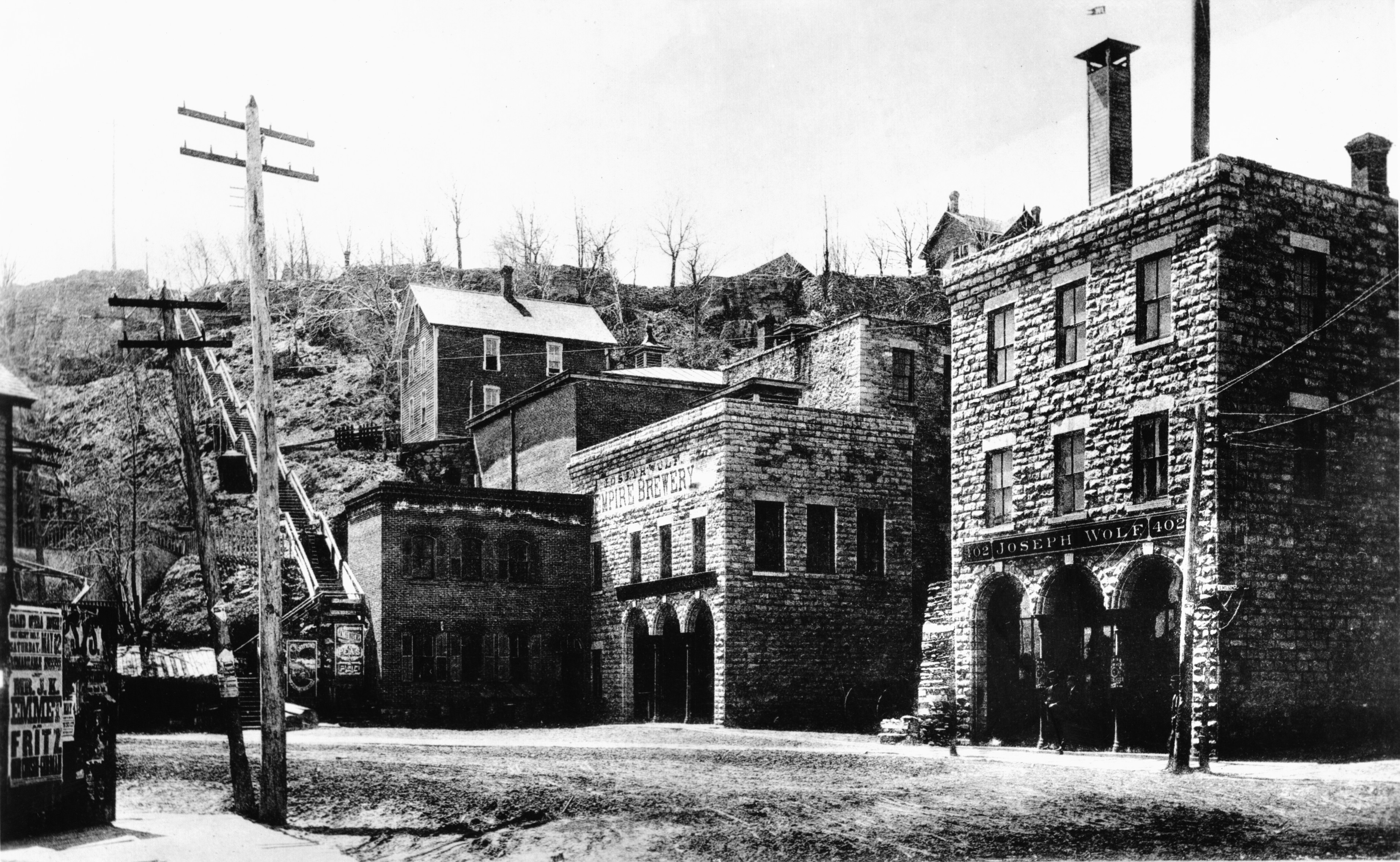Receive the Historical Messenger in your inbox once every two weeks by signing up for our mailing list!
|
This issue: Contents
Tuesday, June 16th, 2015
Editor’s NoteHello hello hello! Welcome to the latest issue of the Historical Messenger! I’d like to start off with a quick Boutwell House update here for you folks. First off, our GoFundMe campaign has now raised $675! But monitary donations aren’t the only way to help the project. Last weekend a group of passionate volunteers made the first steps to restoring this piece of our history by cleaning up the house and property! We’ll definitely have more clean-up days in the future, so keep an eye on our social media for more details. Thank you for the support! …the rest of today’s issue is all about beer! Partially because it’s the perfect weather to sit outside and knock-back a cold one, but mostly because the Hay Lake Beer Tasting is this Saturday! Check out our first bit of News for all the mouth-watering details. We’ll use our second bit of News to introduce you to this summer’s WCHS interns! I’ll also identify the alcohol-accessory from last issue’s “What Is This Thing?!” and introduce our 10th mystery item! In today’s Old News, you’ll read a suggestion from a local man that would feel more at home in an H.G. Wells novel or in a slurred barroom conversation than in the editorial section. These days, smaller local craft brewers are growing more and more popular. Well in today’s Featured Article you’ll read about how Stillwater was ahead of that trend…way back in the late 1800s! Want to learn more about the history of Washington County? “Like” WCHS on Facebook, follow us on Twitter and now introducing our intern-run Instagram! Sean Pallas Historical Messenger editor and Warden’s House Site Manager WCHS News8th Annual Hay Lake Beer Tasting Join the Washington County Historical Society this Saturday, June 20th, 2015 from 4:00-7:00pm for the 8th Annual Hay Lake Beer Tasting Fundraiser & Silent Auction. Admission to the event is $15 per person and participants must me 21 years or older. The proceeds from the event help to fund the Washington County Historical Society and its programs.For the eighth year the Hay Lake School Museum Beer Tasting and Silent auction has become a keystone fundraiser for the Washington County Historical Society. This year sponsored by Lift Bridge Brewing will include fourteen different breweries from around the region. Many Minnesota favorites will be participating; Joseph Wolf Brewing, Mankato Brewing, East Lake Craft Brewery, Granite City Brewing, Summit Brewing, Opinion Brewery of Newport, and more! Join the Washington County Historical Society this Saturday, June 20th, 2015 from 4:00-7:00pm for the 8th Annual Hay Lake Beer Tasting Fundraiser & Silent Auction. Admission to the event is $15 per person and participants must me 21 years or older. The proceeds from the event help to fund the Washington County Historical Society and its programs.For the eighth year the Hay Lake School Museum Beer Tasting and Silent auction has become a keystone fundraiser for the Washington County Historical Society. This year sponsored by Lift Bridge Brewing will include fourteen different breweries from around the region. Many Minnesota favorites will be participating; Joseph Wolf Brewing, Mankato Brewing, East Lake Craft Brewery, Granite City Brewing, Summit Brewing, Opinion Brewery of Newport, and more!
The beer is just a part of it, as the tasting also will consist of food from the Scandia-Marine Lions Club and snacks will be provided by Dot’s Homestyle Pretzels. Author Doug Hoverson, “Land of Amber Waters: The History of Brewing in Minnesota” will be giving a short presentation preceding the event inside the Hay Lake School and Photographer Mark Fay, “Bottom’s Up: A Toast to Wisconsin’s Historic Taverns and Breweries” will also be speaking. Their books will be for sale at the event. Justin Miner of the Johnsdale Paranormal Group will also be at Hay Lake to discuss the upcoming Warden’s House Investigation Raffle. Have you ever wanted to hunt ghosts with the experts? This is your chance! There will also be vintage base ball played on the field next to the museum near the Lions Pavilion. The St. Croix Base Ball Club, Menomonie Blue Caps and the Rum River Rovers will play several timed matches starting at Noon. The vintage base ball matches, played by the rules of 1860, are free to the public. In addition, there will be a silent auction that includes items from Minnesota Vikings, Minnesota Timberwolves, Minnesota Orchestra, Canterbury Park, Water Street Inn, Dancing Dragonfly Winery, and much more from all over Minnesota & Wisconsin. The Hay Lake School Museum is located at 14020 195th St N, Marine on St Croix, MN 55047. Contact Dustyn Dubuque at dustyn.dubuque@hotmail.com or 651-433-4019 with any questions regarding this event or to schedule a tour of the museum. More: Events WCHS NewsWCHS Interns
They’ll help with events, develop research projects …and they also want to share our massive collection of historic photographs with you! Check out the new WCHS Instagram and explore the visual history of Washington County with our interns! (…plus they’ve been working really hard on some truly awful puns…so you can enjoy that too!) Swing by either of our museums, one of our events, or our booth at the Washington County Fair and say ‘Hello!’ to these future historians! Photo: From Left to Right (Alicia Tipcke, Lauren Anderson, Maja Proescholdt) …and behind them Rev. Boutwell! More: WCHS Intern Instagram 
What is This Thing?!What Is This Thing?! (Round 10) Whew! Last issue’s What Is This Thing?! left more than a few heads scratching. A couple folks supposed it was for planting bulb plants like onions or tulips while others guessed it might have been used to tap into trees to harvest sap. But a couple of you still managed to hit the nail right on the head with your guess! Round 9’s mystery item was known as a ‘bung-hole auger’ or ‘reamer’. A ‘bung-hole’ is the small circular hole that is bored into the sides of whiskey barrels. Then they’d either place a tap into the hole or a cork when it was being stored. In the 1880s, “down river Whiskey” (along with local beer) was a popular beverage served at many of Stillwater’s forty-three saloons. Bar owners would often offer a free lunch to bring in the crowds of thirsty lumberjacks. An improvement to the device was patented in 1882 which allowed the wood drilled out by the auger to be removed from an opening in the side of the borer. Can you identify the WCHS artifact photographed above? If you’d care to venture an answer, you can send an email to me at spallas.wchs@gmail.com, tweet @WCHSMN, or post your guess on our Facebook page. Good luck! Old NewsLet’s Blow Up Some Clouds…for Science!
So while the following suggestion for controling Mother Nature seems squarely in the realm of science-fiction, Stillwater wasn’t the only community to suppose that explosives could coax rain from clouds. Even Popular Mechanics was still discussing the ‘success stories’ of the practice in 1912! The supportive comments at the end of the article by the Stillwater Messenger editor further reveal this idea wasn’t seen as a hair-brained scheme or the ravings of a lunatic – science would prevail over all and Stillwater wanted to reap the rewards. Why Not Try? – Stillwater Messenger – June 16, 1900 We spend lots of money for city improvements, celebrations, etc. Isn’t it worth while to raise $50 or $100 to buy some dynamite and balloons in order to shake down the rain from the clouds hovering over us? We don’t know much about rainmaking but actually believe that under conditions like Wednesday evening last, when rain clouds were floating by, concussions of the air would have the desired effect; If it did not we could console ourselves with having failed in a good cause. Respectfully referred to the city Improvement committee, or any one having the public welfare at heart. C.C.P The foregoing article, crowded out of last week’s issue by late news matter, is well worth consideration. The science of rain making is as yet in its infancy but is destined to be, and in the near future, too, of the utmost importance along every line of trade, as all depend upon agriculture. Featured ArticleWhere We Wet Our Whistlesby Brent Peterson In 1851, Norbert Kimmick started a small whisky still on the corner of third and Chestnut Streets in Stillwater. The still was located in his kitchen and he made about five barrels of whisky per week. The next year, Kimmick built a brewery and operated it for about two years before taking on a partner, Frank Aiple. Together they ran the operation until Kimmick’s death in 1857.
Mrs. Aiple then continued the operation of the brewery until she again married, this time to Mr. Hermann Tepass, on December 14, 1869. The old kettle that served the Aiple brewery for nearly 30 years was sold to a brewery in Hillsboro, Wisconsin in August 1890. The following month, two buildings on the brewery grounds caught fire. Jacob Bean, of Hersey & Bean Lumber Company across the street, noticed the blaze and shut down his mill. The mill hands raced to the fire and using the mills three hose lines, extinguished the fire before any damage to the brewery could occur. In the Schulenberg Addition to Stillwater, commonly known as “Dutchtown,” there was a man named Gerhardt Knips who began a brewery in late 1858 or early 1859. This part of Stillwater had the largest German settlement in the city and it would only make sense that they would bring their brand of beverage to the area. Knips, with his wife and young son, constructed a three-story building at a cost of $1,000. They came from St. Louis, and it was here that he began the “St. Croix Brewing Company.” In the Stillwater Messenger of January 2, 1866, there was described a fire at Knip’s Brewery in Schulenberg’s Addition. The fire started in the early evening. The two upper stories were “constructed of wood and occupied as a residence.” This portion of the building was completely engulfed in flames, “but through the exertions of our citizens the most valuable portion of the building, cellars, and most of the stock were saved. Loss $1,500.” For the citizens of Dutchtown, their beer was saved! In an article in the Stillwater Gazette on December 13, 1870, the paper commented on Knips recent improvements to the brewery. “He has made large excavations under the bluff in the rear of his brewery, about 40 feet in length,” said the report. The reporter also commented on the expense of these improvements, saying, “He has expended this season about $1,000 in the way of repairs and improvements.” Seven years later, the Gazette reported that Knips was getting out of the brewing business. “We understand” the reporter said, “that the Knips brewery has been leased to Messrs. Fred Maisch, D. Millbrook and Jos. Honar – the latter a practical brewer of good repute. The new firm will take possession of the works to-morrow, Feb. 1. We wish the success.” The new enterprise did not work out, and just a few years later, the brewery buildings were sold to Seymour, Sabin & Company. At the peek of production, the Knips brewery produced 450 barrels of beer annually. The Knips family moved away from Stillwater in the late 1870s to Nobles County, Minnesota. On March 18, 1879, the organizational meeting for Leota Township in Nobles County was held at the Gerhardt Knips home. Their daughter, Clara, stayed in Stillwater and was one of the first graduates from Stillwater High School in 1876. She later became a schoolteacher in Stillwater. Also staying in Stillwater was their son Emil, who worked for the Stillwater Mills. Peter Newhouse later purchased the brewery building. He made it into a boarding house in which 16 families lived there during the First World War. When the state decided to widen Highway 95 in 1935, the building was torn down. The back wall was used as a retaining wall for the bluffs, and it was on that wall that a plaque dedicated to the Tamarack House was placed. According to the “History of Washington County and the St. Croix Valley” published in 1881, the “Marine brewery was started about 1856 by [John] Kaufman, a German from Hudson.” Then, about three years later, Swiss born John Graf purchased Kaufman’s brewery, and in 1865 constructed larger buildings for development of a bigger brewery with his son Emil. In 1870 the brewery was sold to John F. Wichman and Henry Gartner. These gentlemen had come to Marine in the mid-1850s and were now embarking on making this one of the premiere breweries in the state. The brewery consisted at this time of a saloon and Wichman’s home, and the buildings were near the river bluff just south of the millstream, near where the mill site historic marker is standing today. By 1875, the Marine Brewery operated by Wichman & Gartner was making approximately 185 barrels of beer annually. In 1880, after Gartner’s death, Wichman became the sole owner and the production of the brewery was increased. In 1880, the brewery manufactured 300 barrels of beer, using nine hundred bushels of barley and employing two men. At 8:30 in the evening on February 25, 1886, flames were spotted coming from the dry kiln in the basement of the brewery. The alarm was sounded and the towns’ people came “speedily upon the scene” but the fire raced through the brewery building and any attempt to save it was abandoned. However, the flames were spreading fast and it was possible that the fire could reach the planning mill and lumberyard. A bucket brigade was started and the mill and yard were saved. The fire did spread to the Wichman’s home, which was later destroyed by the fire but some of the household items were brought out to safety. The estimates of the damage of the fire ranged from $3,000 to $3,500 and since the Wichman’s had no insurance, the brewery was a total loss. The Stillwater Gazette proclaimed “the citizens of Marine are deserving of much credit for their determined fight against great odds to prevent a further spread of the fire which at one time threatened to destroy the entire place.” On the day of the fire, the Marine Village Council held a meeting and appointed John Bevens to investigate the cost of a suitable fire engine and 500 feet of hose. Later, on April 10, 1886, the council voted to purchase such an engine, which officially established the Marine Volunteer Fire Department. Wichman did rebuild but the brewery was never put back into operation. Wichman died in December 1915 and his building was used in many different ways, from hotels to restaurants, a couple saloons and even an ice cream shop. The building was torn down in the late 1950s and there was some talk of making the site a nursing home. Eventually, according to James T. Dunn, the site was cleared completely in the fall of 1972 by the Minnesota Historical Society and is today a part of the historic mill property.
In May 1876, Joseph Wolf, the brother of Martin, purchased the whole business. In 1880 a brick office block was built adjoining the brewery. The firm was dissolved then incorporated under the name of Joseph Wolf Company in 1896, with Joseph Wolf as President of the firm. This new firm included three of Wolf’s sons and two son-in-laws. The Wolf Brewery is the best known brewery from Stillwater, at one time producing more than 25,000 barrels of beer a year, and continued to produce some of the best beer and whisky in the State of Minnesota until the 18th amendment put an end to the brewery. It took nearly a century for beer brewing to return to Stillwater after Prohibiton. And this Saturday, you’ll be able to sample a few of those local brews at our 8th Annual Beer Tasting at Hay Lake – including the renewed Wolf Brewing Company! Cheers! |
Upcoming Events
More information: WCHS Events >>> Preserve the Past, Share in the Future!Become a member of the Washington County Historical Society! Membership is one way that you can help support the Washington County Historical Society. Your membership helps us collect, preserve, and disseminate the history of Washington County for county residents and visitors in the belief that a historical perspective enhances our understanding of community and sense of place. Benefits of membership:
The Washington County Historical Society has depended on membership ever since it was formed in 1934. Please show your support for the organization by becoming a member today. More: WCHS Membership >>> Washington County Historical SocietyMission StatementWashington County Historical Society collects, preserves, and disseminates the history of the county and state of Minnesota.
|
|||||||
 One of my favorite programs here at WCHS is our summer internship. For the next 10 week Lauren Anderson, Maja Proescholdt, and Alicia Tipcke will be learning the ins-and-outs of local history museums at the Warden’s House and Hay Lake. Lauren is a graduate student at Eau Claire, Maja has just graduated from Luther College in Iowa and Alicia is studying at the College of St. Scholastica in Duluth. All three are pursuing careers in Public History and are receiving their first real taste of the field here at WCHS.
One of my favorite programs here at WCHS is our summer internship. For the next 10 week Lauren Anderson, Maja Proescholdt, and Alicia Tipcke will be learning the ins-and-outs of local history museums at the Warden’s House and Hay Lake. Lauren is a graduate student at Eau Claire, Maja has just graduated from Luther College in Iowa and Alicia is studying at the College of St. Scholastica in Duluth. All three are pursuing careers in Public History and are receiving their first real taste of the field here at WCHS. In past issue’s we’ve discussed how the beginning of the 20th century was an amazing time to be alive. Technological wonders seem to be churned out every day. By 1900, wireless telegraphy was being used for instant communication across the English Channel – in less than a year it would be transmitted across the Atlantic. At the same time this article was published, the Wright Brothers were spending their first summer in Kitty Hawk testing their prototype flying machine.
In past issue’s we’ve discussed how the beginning of the 20th century was an amazing time to be alive. Technological wonders seem to be churned out every day. By 1900, wireless telegraphy was being used for instant communication across the English Channel – in less than a year it would be transmitted across the Atlantic. At the same time this article was published, the Wright Brothers were spending their first summer in Kitty Hawk testing their prototype flying machine.


